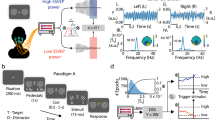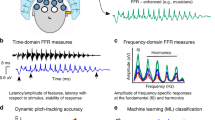Abstract
STUDIES of human auditory1–3 and somatosensory3 modalities have shown that there is an oscillatory response in the γ-band (at about 40 Hz) frequency which is elicited by either steady state1–3 or transient4 stimulation. The auditory 40-Hz response is generated at least partially in the auditory cortex4,5as a result of thalamocortical interaction6 and may serve perceptual integration7,8 and conscious perception9. A connection to selective attention has been implied in human10 and animal11 studies, although the evidence is inconclusive12. Moreover, fundamental differences between the human and animal 40-Hz responses13 prohibit generalization. Furthermore, most experiments have used steady-state stimulation during which the brain does not regain its resting state between stimuli as it does when transient stimulation is used14. Here we study the effect of selective attention on the auditory γ-band (40-Hz) transient response using subjects listening to tone pips presented in one ear while ignoring a concurrent sequence of tone pips in the other ear. The 40-Hz response was larger when subjects paid attention to stimuli rather than ignored them. This attention effect was most pronounced over the frontal and central scalp areas. Our results demonstrate a physiological correlate of selective attention in the 40-Hz transient response in humans.
This is a preview of subscription content, access via your institution
Access options
Subscribe to this journal
Receive 51 print issues and online access
$199.00 per year
only $3.90 per issue
Buy this article
- Purchase on Springer Link
- Instant access to full article PDF
Prices may be subject to local taxes which are calculated during checkout
Similar content being viewed by others
References
Galambos, R., Makeig, S. & Talmachoff, P. J. Proc. natn. Acad. Sci, U.S.A. 78, 2643–2647 (1981).
Makeig, S. & Galambos, R. Soc. Neurosci. Abstr. 15, 113 (1989).
Galambos, R. Ann. N.Y. Acad. Sci. U.S.A. 388, 722–728 (1982).
Pantev, C. et al. Proc. natn. Acad. Sci. U.S.A. 88, 8996–9000 (1991).
Mäkelä, J. P. & Hari, R. Electroenceph. clin. Neurophys. 66, 539–546 (1987).
Ribary, U. et al. Proc. natn. Acad. Sci. U.S.A. 88, 11037–11041 (1991).
Gray, C. M. et al. Nature 338, 334–337 (1989).
Engel, A. K. et al. Trends Neurosci. 15, 218–226 (1992).
Llinás, R. & Pare, D. Neuroscience 44, 521–535 (1991).
Sheer, D. E. In Self-regulation of the Brain and Behaviour (eds Elbert, T., Rockstroh, B., Lutzenberger, W. & Birbaumer, N., 64–84 (Springer, Berlin, 1984).
Rougeul, A. et al. Electroenceph. clin. Neurophys. 46, 310–319 (1979).
Linden, R. D. et al. Electroenceph. clin. Neurophys. 66, 145–159 (1987).
Galambos, R. in Induced Rhythms in the Brain, (eds Bullock, T. H. & Başar, E., 201–216 Birkhäuser, Boston, 1991).
Kaufman, L. & Williamson, S. J. in Auditory Evoked Magnetic Fields and Electric Potentials (eds Grandori, F., Hoke, M. & Romani, G. L.) 283–312 (Karger, Basel. 1990).
Daubechies, I. IEEE Transactions on Information Theory 36, 961–1005 (1990).
Gabor, D. Proc. IEE 93, 429–457 (1946).
Harter, M. R. & Aine, C. J. in Varieties of Attention (eds Parasuraman, R. & Davies, D. R. Academic, London (1984).
Skinner, J. E. & Yingling, C. D. Progr. clin. Neurophys. 1, 30–69 (1977).
Hillyard, S. A. & Mangun, G. R. in Current Trends in Event-Related Potential Research EEG suppl. 40. (eds Johnson, R., Parasuraman, R. & Rohrbaugh, J. W.) 61–67 (Elsevier, Amsterdam 1984).
Oatman, L. Exp. Neurol. 32, 341–356 (1971).
Ribary, U. et al. Eur. J. Neurosci. Suppl. 1, 44.17 (1988).
Ribary, U. et al. in Advances in Biomagnetism (eds Williamson, S., Hoke, M., Stroink. G. & Kotani, M.) 311–314 (Plenum, New York, 1989).
Author information
Authors and Affiliations
Rights and permissions
About this article
Cite this article
Tiitinen, H., Sinkkonen, J., Reinikainen, K. et al. Selective attention enhances the auditory 40-Hz transient response in humans. Nature 364, 59–60 (1993). https://doi.org/10.1038/364059a0
Received:
Accepted:
Issue Date:
DOI: https://doi.org/10.1038/364059a0
This article is cited by
-
Silencing CA1 pyramidal cells output reveals the role of feedback inhibition in hippocampal oscillations
Nature Communications (2024)
-
Construction of a Hierarchical Organization in Semantic Memory: A Model Based on Neural Masses and Gamma-Band Synchronization
Cognitive Computation (2024)
-
Forty-hertz light stimulation does not entrain native gamma oscillations in Alzheimer’s disease model mice
Nature Neuroscience (2023)
-
Emergence of global synchronization in directed excitatory networks of type I neurons
Scientific Reports (2020)
-
Minimally-verbal children with autism show deficits in theta and gamma oscillations during processing of semantically-related visual information
Scientific Reports (2019)
Comments
By submitting a comment you agree to abide by our Terms and Community Guidelines. If you find something abusive or that does not comply with our terms or guidelines please flag it as inappropriate.



